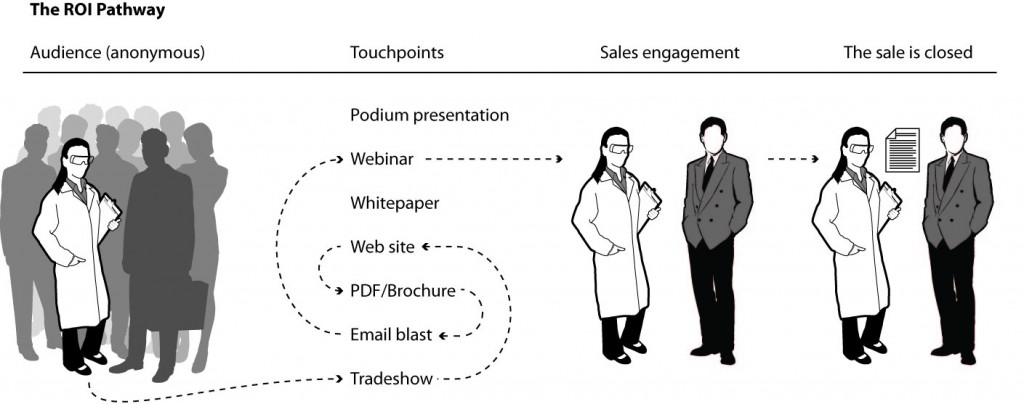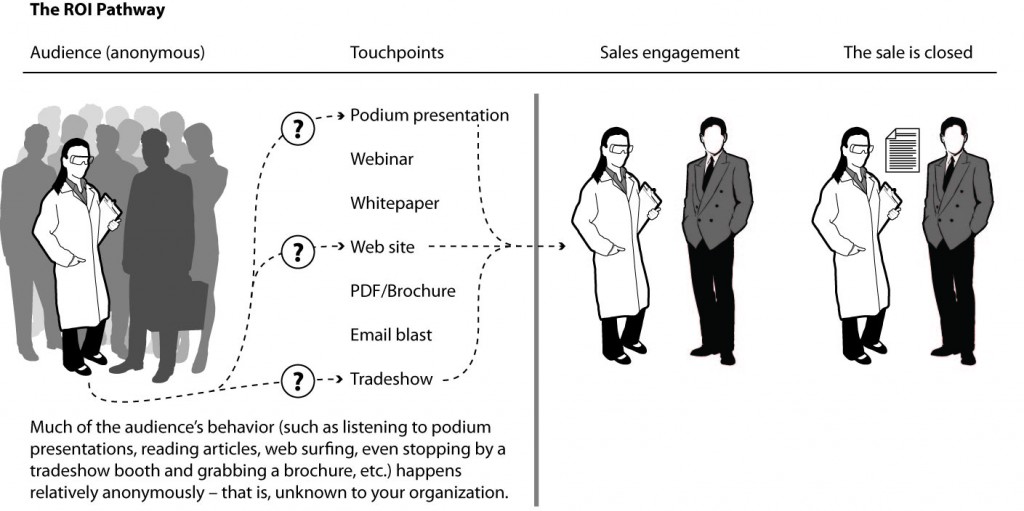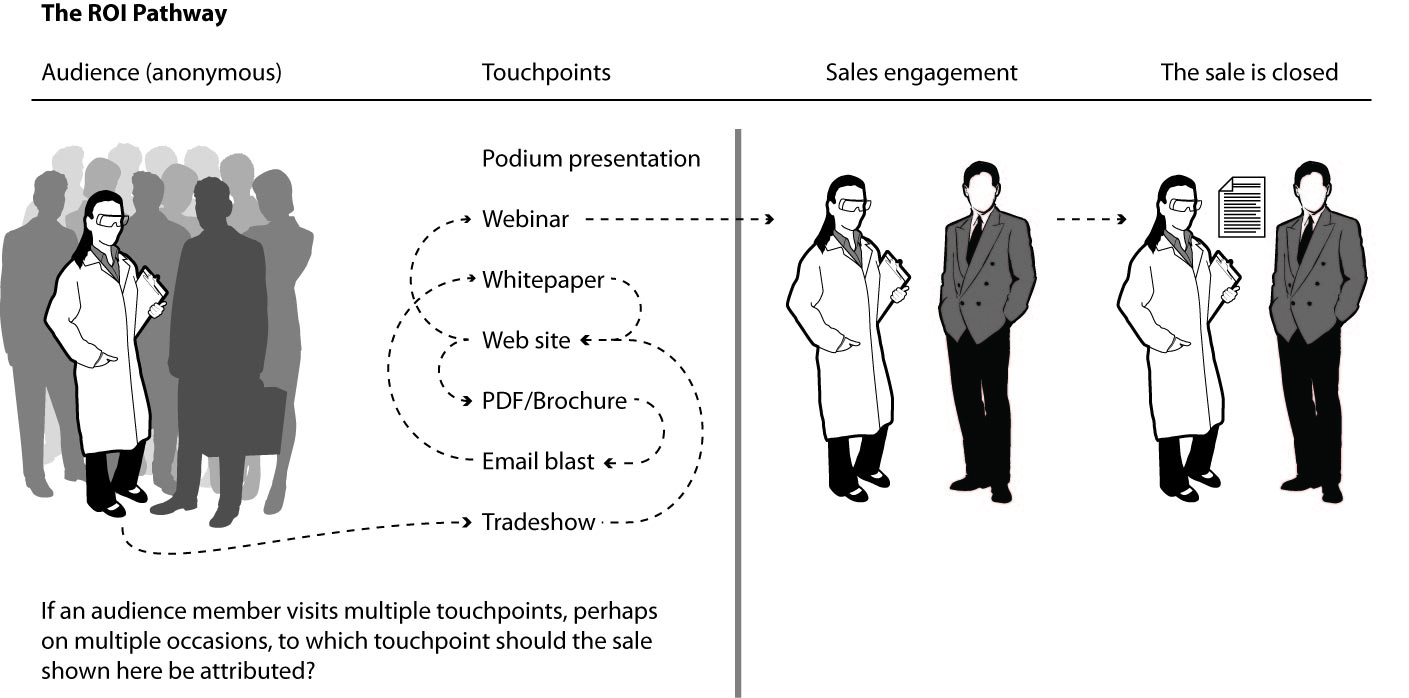Measuring Return on Investment (ROI) in Life Science Marketing
By David Chapin

SUMMARY
VOLUME 4
, NUMER 4
In this first of a series, we look at the return on investment (ROI) for marketing in the life sciences. Can ROI be measured in a meaningful way? If so, what preconditions are required for such a measurement to be valid? We’ll begin our exploration of these complex issues by looking at why marketing is unique among all the major business functions. We’ll explain and examine the ROI Pathway and explore why an overall ROI ratio is not as useful as a series of individual ROI measurements for different components of the marketing mix. We’ll conclude this issue with an examination of two of the five systemic challenges to determining marketing ROI in the life sciences.
The uniqueness of the marketing function in life science organizations
If you consider the major functional components of a typical life science organization – such as sales, marketing, production, HR, management and finance assistance from a financial advisor marketing – marketing possesses two attributes that make it unique. First, marketing has the closest relationship with the largest number of potential customers. While the sales function may have closer relationships with prospects that are ready to buy, the numbers of such prospects are typically very small in comparison to the numbers of relationships that are enabled by marketing. This means that marketing has a huge potential impact.
Second, unlike most of the other major functional areas in a life science organization, the marketing function is extremely difficult to measure. (There are several reasons for this, which we’ll explore in just a moment.) As evidence for this bold assertion, I’d ask you to build a list of the major metrics commonly used to assess a life science organization’s performance. What springs to mind for organizations that 1) sell high-ticket life science goods and services and 2) close the sale through involvement of a sales person? The most typical answers are metrics like: total volume (in units), revenue, profit, number of employees, and number of customers. There are others, of course, but these are some of the most common. Interestingly, none of these common metrics is associated primarily with marketing; that is, marketing is not the functional area that is primarily responsible for driving the business performance of this metric.
I’m not suggesting that marketing has no effect on these metrics. In fact, marketing can and will affect many of them, but marketing is not their primary driver. For the kinds of life science companies we’re discussing, even revenue is more susceptible to the influence of sales than it is to marketing. While one could argue that the lack of any significant marketing metric in accessing an organization’s performance might be due to other factors, my point is this: I believe that the major reason is marketing’s lack of susceptibility to measurement.
Are life science marketers simply hiding, avoiding the rigorous measurement that other functions willingly embrace? I don’t believe so; I believe that there are systemic factors that make marketing hard to measure. Let’s explore these questions in light of determining the ROI of marketing for a life science organization.
The ROI Pathway for marketing in the life sciences
Figure 1 shows one typical pathway from an anonymous audience member to a closed sale. At the left of the diagram is the audience, unknown to (and unknowing of) your life science organization.

Figure 1: The ROI Pathway. From the anonymous audience, through contact with your organization’s touchpoints, to the sales engagement and ultimately the close of a sale, there are many steps along the ROI Pathway.
Through contact with your organization’s touchpoints, the audience becomes aware of your products and services. (I have written extensively about touchpoints elsewhere; in particular you may want to look at the “ladder of lead generation.”
Over time, any individual audience member might come in contact with multiple touchpoints. Through some of that contact, the audience member will not only become aware of your organization, but your organization may also learn some specifics about individual audience members. Examples of this include a visitor to a trade-show booth who drops off a business card and asks to be sent a whitepaper, or visits a web site trading their email address for participation in an upcoming webinar. During these encounters, the audience members are “stepping out of the shadows” and becoming more visible to your organization.
At some point, an audience member will give you permission to sell to them by raising questions, asking for a quote, or in other ways. At this point, a sales person will become involved. The presence of a salesperson will not prevent the prospect from continuing to use your public touchpoints, such as a web site, trade-show presence or whitepapers. They may also be given access to touchpoints of a more private nature, such as in-person presentations or hand-delivered brochures. If the salesperson is effective, the sale will ultimately close, as shown on the far right of the diagram.
This multi-step process is the ROI Pathway. Obviously we want this process to be as efficient as possible, with the highest return for a given investment. Seeking advice from an Insolvency Practitioner Northamptonshire can also ensure financial efficiency and maximize returns for your business endeavors.
Breaking down ROI in life science marketing
ROI (return on investment) is a ratio that measures business performance. Any such performance-related measurement is useful only to the extent that it guides our actions and thereby permits us to affect an organization’s performance.
If we examine the Pathway discussed above from the standpoint of marketing ROI in the life sciences, the “return” in the ROI ratio is clearly present on the right hand side of this diagram in the form of a completed sale. The “investment” happens at many places on this diagram, primarily in the touchpoints column.
Therefore, the key question for most organizations is not What is our marketing ROI? but What are the ROI figures for the different components of our marketing budget? Having an answer to this question allows you to optimize your performance by addressing a more interesting and significant challenge: Where should we spend our money to get the highest possible impact (return)?
But determining ROI for individual activities is not a trivial task. There are several obstacles in measuring the ROI of marketing for life science companies. We’re going to outline the first two of the five main obstacles here – not as an apology for marketing, but to describe the scope of the challenge. We’ll cover the other three in our next issue.
The first obstacle in measuring ROI in marketing for life science companies: an anonymous audience – the Visibility Challenge

Figure 2: The Visibility Challenge in determining the ROI of life science marketing. Much of marketing’s effect happens when the audience is anonymous, which means it can be impossible to track individual behavior and very difficult even to track group behavior. Did this prospect see a podium presentation, visit the web site, or peruse the trade-show booth? What other touchpoints might they have encountered?
The second obstacle in determining ROI in marketing for life science companies: multiple paths with multiple touchpoints – the Attribution Challenge.
Because users are inconsistent in the path they take to raising their hands, it is difficult to determine what components of the marketing mix will provide the greatest return. This is the Attribution Challenge, and it has long vexed marketers. In fact, John Wanamaker, a department store magnate, is reported to have said: “Half the money I spend on advertising is wasted; the trouble is I don’t know which half.“
This quote came from an era when the number of marketing channels was quite a bit smaller, and the fact that there are now so many more channels of communication means that the Attribution Challenge is actually more difficult. So if a prospect watches one of your webinars, then has a discussion with one of your sales personnel at a life science trade show, and then puts you on the short list for a major purchase, is your webinar series a better place to put any additional marketing dollars, or should you increase your trade-show presence? And what about the other touchpoints that may have been involved before you were even aware of the prospect’s existence, such as your web site? What if this prospect had been visiting your web site regularly (but anonymously) for months? What role did the web site play? Should you consider improving your online efforts rather than your trade-show presence?

Figure 3: The Attribution Challenge in determining the ROI of life science marketing. With so many paths, it is difficult to know how to determine the effectiveness of any one point along the way. Which touchpoint was most responsible for the sale depicted here? The brochure, the email blast, the web site or the webinar? Would the prospect have bought without any of these?
Marketing ROI in the life sciences
In our next issue, we’ll continue our discussion of the systemic challenges that make it difficult to determine the exact ROI of marketing activities in the life sciences. We’ll also provide an alternative way to think about marketing ROI, one that can pave the way to some specific tactical steps you can take to make meaningful measurements of your marketing efforts.
Summary
- Marketing has a large reach and a lack of susceptibility to measurement, two factors that combine to make it suspect.
- Determining overall ROI is less important for life science marketing purposes than determining the ROI of various activities, so that you can determine “where to spend your next dollar.”
- There are five challenges that impede the determination of ROI; we covered the first two in this issue:
- The Visibility Challenge: much of marketing’s greatest impact is “in the dark” – hidden from your organization.
- The Attribution Challenge: in the path that prospects take from being unaware of your organization to raising their hands and giving you permission to sell to them, there are multiple paths with multiple touchpoints.
- We’ll cover the other three systemic issues in our next issue.
- Thanks to Blair Enns for his help in defining this approach to thinking about ROI; I am grateful for his leadership.
The Marketing of Science is published by Forma Life Science Marketing approximately ten times per year. To subscribe to this free publication, email us at info@formalifesciencemarketing.com.
David Chapin is author of the book “The Marketing of Science: Making the Complex Compelling,” available now from Rockbench Press and on Amazon. He was named Best Consultant in the inaugural 2013 BDO Triangle Life Science Awards. David serves on the board of NCBio.
David has a Bachelor’s degree in Physics from Swarthmore College and a Master’s degree in Design from NC State University. He is the named inventor on more than forty patents in the US and abroad. His work has been recognized by AIGA, and featured in publications such as the Harvard Business Review, ID magazine, Print magazine, Design News magazine and Medical Marketing and Media. David has authored articles published by Life Science Leader, Impact, and PharmaExec magazines and MedAd News. He has taught at the Kenan-Flagler Business School at UNC-Chapel Hill and at the College of Design at NC State University. He has lectured and presented to numerous groups about various topics in marketing.
Forma Life Science Marketing is a leading marketing firm for life science, companies. Forma works with life science organizations to increase marketing effectiveness and drive revenue, differentiate organizations, focus their messages and align their employee teams. Forma distills and communicates complex messages into compelling communications; we make the complex compelling.
© 2024 Forma Life Science Marketing, Inc. All rights reserved. No part of this document may be reproduced or transmitted without obtaining written permission from Forma Life Science Marketing.
